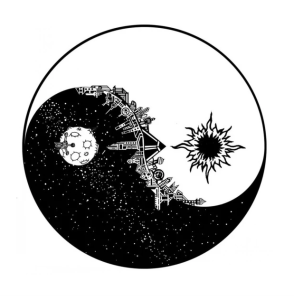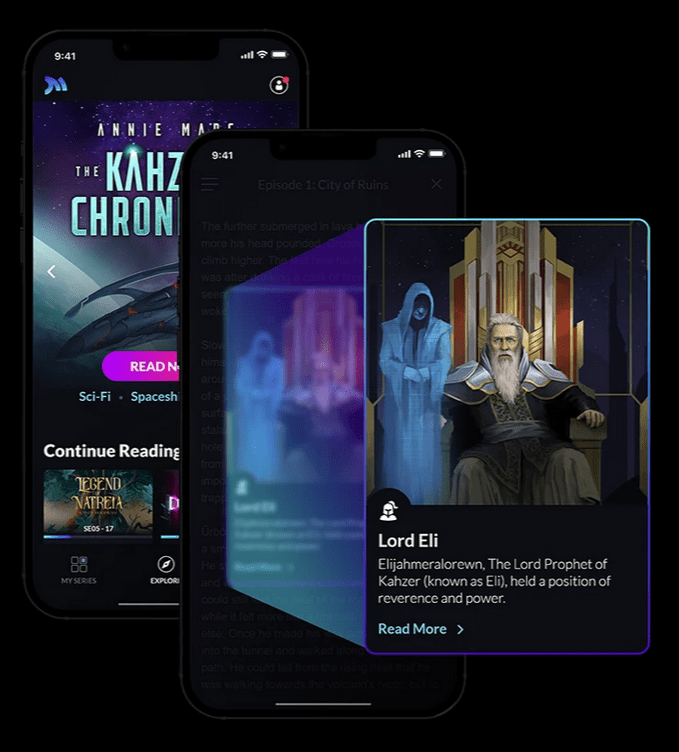In the March/April 2022 issue of Galaxy’s Edge Magazine (which you can read or buy here), there are stories by Harry Turtledove, Mike Resnick, Tai Yi, Torion Oey, Katharine Kerr, and more. Plus, Jean Marie Ward finishes up Part 2 of her interview with John Scalzi, talking about his new book, The Kaiju Preservation Society.
And as always, we have a selection of insightful science fiction and fantasy book reviews from Robert Chwedyk.
In this issue, he takes a look at:
- Sweep of Stars by Maurice Broaddus
- Star Eater by Kerstin Hall
- Destroyer of Light by Jennifer Marie Brissett
- The Reinvented Heart edited by Cat Rambo and Jennifer Brozek
Sweep of Stars by Maurice Broaddus
I’ve been waiting for this book for a while. I’m familiar with some of Broaddus’s other writings and was excited to see what he would do with a now-familiar form like a science fiction epic trilogy. I am not disappointed.
The beginning has the now-common lists of characters and time line that you’re going to skip back to later but you have no time for now. You want to see how the novel opens and if it will compel you to keep reading until you reach the final page:
Your name is Leah Adisa. For now.
Choosing a name for yourself is not something to be entered into lightly. It is a promise you make to the universe. Or it to you. A name is the story of yourself you present to the world, a label to define you. That is the entire point of the Naming Ceremony: you are finally of age to interpret yourself and into the Muungano community as a full free member.
The paragraphs that follow continue to orient you to a world you’ve not encountered in a novel before: the African-based hegemony (of sorts) of the Muungano people, which extends from Earth to Titan, and a little further to a mining colony named Oyigiyigi. We may be familiar with spacefaring empires extending to the outer planets, but we’ve usually seen them from a Western perspective, a sort of continuation of “American” middle-class culture, or how Octavia Butler once put it, “The same as now, only more so.” In this novel, we’re not just discovering new worlds but old worlds seen in new ways, from a new perspective. We’re discovering what, for we readers, is a whole new culture.
It’s not as if this hasn’t been attempted before, but Broaddus seems to have found the right angle or point of view from which to address we readers that neither frustrates us with opaque “strangeness” or presumes we are simpletons who need every little detail explained. The result is a clarity of narrative that is truly splendid.

And that narrative is…complex. To say the least. You expect that in a trilogy. But that same angle or point of view, or better still, that voice, never leaves you confused as it shifts from setting to setting and person to person.
And I was intensely impressed with Broaddus’s focus upon his people. He has great insight into human concerns, their desires and needs, how they express them and how they attempt to conceal them. Some authors of this sort of work become so overwhelmed by their own world building, they can only manage to “populate” their novels. With Sweep of Stars, one gets the feeling this story began with the people. The world came later, or simultaneously, so the human scale is never lost.
Sweep of Stars exercises the best traditions of science fiction while providing new perspectives and redefining the expectations we place upon such works. Some readers may find it rough going, but I encourage them to stay with it. On rare occasions, even for science fiction readers, one encounters a book that truly changes the way one sees the world, yesterday, today and most certainly tomorrow. I believe this is one of them.
Star Eater by Kerstin Hall
Fantasy readers, I can guarantee you have never read a novel like this. I can extend that guarantee to everyone else who may be curious. The borders between fantasy, science fiction, and horror are here either discarded or ignored. And to you aspiring writers out there: remember all those things your esteemed writing teachers said you can never get away with? Well, Kerstin Hall gets away with most of them. Honestly, I don’t know how. I suspect she does it through a modicum of chutzpah and a great deal of skill.
Something about this novel reminded me of one of those profound pronouncements Marlow makes in Conrad’s “Heart of Darkness”: about “The fascination of the abomination.” But not in a bad way. I will add, though, that some other reviewers have added trigger warnings to their comments, and they can be justified. There are some really rough scenes in here. Be warned.

But…what can be expected from a novel where, if someone were to ask you what it was about, you’d say something like, “Well, it takes place in a city that’s elevated over the world, because on the surface all the men have become zombies. In the city, there’s a sisterhood that acquires magic through cannibalism, and once they have it the magic is manifested in lace. Literally, lace. And that’s just the background for some really Machiavellian intrigue.”
And if this someone asks you further, “Well, who are the good guys?” you will most likely answer, “Well, I’m still trying to figure that out.”
The thing is, you’re still fascinated by these people, either because they have real human facets that accompany these atrocious activities, or because you keep turning pages, muttering to yourself, “They can’t possibly get away with that! Can they?”
They can, with Kerstin Hall telling the tale, and doing so with masterful precision.
Destroyer of Light by Jennifer Marie Brissett
As with Kerstin Hall’s novel, readers should take note that there’s some strong stuff here.
Aspects of this story will strike you as familiar, and I’m not referring to its reimagining of the Persephone myth. Aliens boot us off our planet, genetically modify us and relocate us to a world called Eleusis, where things go “not as planned” from the get-go. There are three habitable areas of the planet, named Day, Dusk and Night. Resources, material and intellectual, and some things more, are not equally distributed. And often, this situation, rather than encouraging cooperation, spawns greed and violence.

We may have read versions of this kind of thing before (suddenly, I’m remembering a Bradbury story called “Frost and Fire”), but not in this way. The central character, Cora, is sympathetic enough, as you might expect, but also enigmatic, but not in any bad way. She is, after all, Persephone, and everything we encounter on Eleusis is a little bent, a little twisted, like what we might encounter through Lewis Carroll’s looking glass if it were being held by James Tiptree Jr. I’m not saying Brissett writes like Tiptree, but her vision shares that same uncompromising intensity.
When you’re dealing with myths, it’s difficult to be otherwise. To paraphrase R. A. Lafferty, the myths aren’t inside us; we are inside them, struggling to get out.
You won’t “get” this book on a first read. It will haunt you, though. And that’s likely one of the things in Destroyer of Light that goes exactly as planned, by Brissett.
The Reinvented Heart edited by Cat Rambo and Jennifer Brozek
Last November, when I went to Windycon, my first “in person” convention in what seemed like ages, I very often heard a word that I really hadn’t encountered much at conventions heretofore: “Romance.”
And that word being used in the denotation of a literary category: those books in the store with the label “Romance” on the spine. Many of us in fandom made fun of those books. We believed them all to have been built on a steadfast, indestructible narrative skeleton: young woman of modest means falls in love with a handsome young man of higher social status, or some other condition which seems to doom their relationship, though the young man reciprocates her feelings. Whatever, their hardships are overcome by the last page and the beautiful couple prepare for a lifetime of happiness. Thousands of novels were built on that skeleton, and billions of copies of those novels were sold. They were reliable. And predictable. And we made fun of them. Their fungible structure seemed a polar opposite of what science fiction was all about. They were allegedly more predictable than Nancy Drew, the Hardy Boys, or Tom Swift.

But the picture was never quite that simple. At least a couple of new generations of readers have grown up since we callow old fogies sniffed at the romance market. Many new science fiction readers began by reading romance novels, then switched over to several of the many “cross-genre” variations, like romances set in fantasy worlds or science-fictional universes. Not to mention the explosion of romances catering to a number of diverse, non-traditional audiences. And many of the newer writers in our field not only got their start in the romance market, but they maintain a presence in that genre while doing other work in ours.
All of that is to say that we should no longer be surprised at having romance fiction discussed at SF cons. It’s here. Get used to it.
And frankly, I’m not really sure if the preceding tangent of mine has any relevance to the brilliant anthology edited by Cat Rambo and Jennifer Brozek, The Reinvented Heart, but I started there, so be it.
The marvelous thing about this anthology is that it left me far removed from the simple definitions of what we’re talking about when we talk about “relationships,” romantic or otherwise.
In her foreword, Rambo quotes the call to authors she made for this book:
Science fiction often thinks about the technology without considering the ways social structures will change as tech changes—or not. What will relationships look like in the future when we have complications like clones, uploaded intelligences, artificial brains, or body augmentation? What happens when emotions like love and friendship span vast distances—in space, in time, and in the heart? And as we acknowledge differences in gender in a way we never have before, what stories are finally given the space in which to emerge?
Any sort of devoted reader of science fiction will no doubt immediately recall any number of stories—by Octavia Butler, or Sturgeon, or Delany, or Sheckley, or Le Guin, or Tiptree, to name just a few—that already address what Rambo and Brozek were looking for, but you’ll have to admit that those gems are rare—exquisite, but rare.
The marvelous thing about this anthology is how successful the editors were in their search to increase this number. This is all fine work, written with great skill, great intelligence, great wit and, perhaps most of all, a discerning and sympathetic eye for the way change can seem at once surprising and inevitable in this world (and any other world you choose to imagine). My favorites, not necessarily the best, works are by Rosemary Claire Smith, Lyda Morehouse, Naomi Kritzer, Fran Wilde, Lauren Ring, Sam Fleming, Xander Odell and Devin Miller. The three sections: “Hearts,” “Hands” and “Minds” are prefaced with poems by Jane Yolen. One need say no more.
Full disclosure: yes, it’s published by Caezik, but I would have grabbed up this anthology no matter who published it. Dozens of themed anthologies come out every year. This one is significantly a keeper.
If you’d like to read more of the great content that’s gone into the March/April issue of Galaxy’s Edge, you can find an issue at Amazon and Barnes & Noble.











